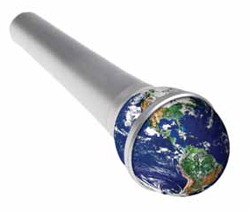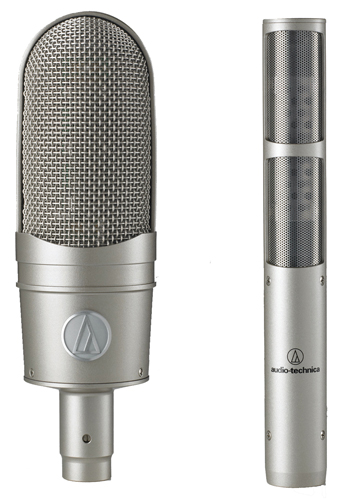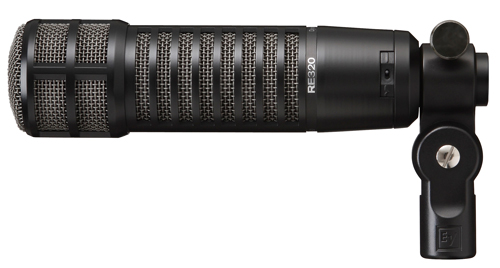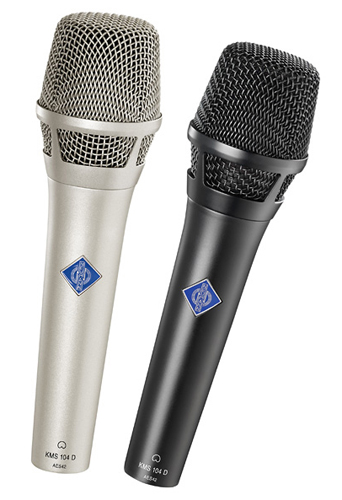
While the live microphone market is full of “old favorites” that continue to the do the job year after year, there’s also a constant drive toward innovation.
Dynamic models remain most popular, but continuing a trend, condenser designs are getting increased traction among both manufacturers and users alike.
Ribbon models, once too fragile for rigorous live sound applications, are no longer so, and provide yet another option in the mic box.
We’ve also seen a notable uptick in the number of quality headworn and earworm mics making their debut over the past year or so. And, Neumann continues to lead the way in the digital mic realm.
In short, there’s more choices than ever, and here we present a look at numerous recent new technologies and designs in the world of microphones for live sound.
RIBBON
The Audio-Technica AT4080 and AT4081 offer side-address active ribbon designs with bidirectional polar patterns, which makes them equally sensitive to sounds originating in front and back of the mic. The AT4080, with a footprint resembling a large-diaphragm condenser, is designed for vocals, horns, strings, acoustic instruments, drum overheads, orchestras, ensembles and guitar cabinets.
The AT4081, with an appearance more like a pencil condenser, is optimized for strings, saxophones and other horns, acoustic instruments, drum overheads, orchestras, ensembles and guitar cabinets; its low-profile stick design maximizes placement options. Phantom power is used for the active electronics, which bring their output to near condenser microphone level.
Neodymium magnets boost output levels. Proprietary MicroLinear ribbon imprint technology minimizes lateral flexing for durable performance and accurate reproduction, and it also cuts distortion. An ultra-fine “pop-stopper” inner mesh helps protect the ribbon elements in both models against damage from wind and plosives.
The new Royer Labs R-101 ribbon model uses a variation of the previously introduced R-121’s durable ribbon transducer, with two advancements especially for live use.
First, a multi-layered wind screen system provides additional protection from air blasts and plosives, reducing wind-related noises getting into the signal, as well as protecting the ribbon element from wind-related damage. This also reduces proximity effect.
Next, the R-101’s ribbon transducer is internally shock mounted via two plates separated by four silicon grommets. If the microphone is dropped or jarred, the internal shock system minimizes impact on the ribbon element.
The Shure KSM313/NE is a bi-directional ribbon with strong off-axis rejection, and it offers a dual-voice design with discrete front-and-rear side sonic signatures for use with amplified instruments or intimate vocal applications.
The dual-voice design can be tuned specifically for the user’s for choice of response: warm and full for amplifiers, or swivel for bright and flattering vocals. The high-tensile strength, toughness, and shape memory of proprietary Roswellite ribbon material replaces traditional foil ribbons for superior resilience at extreme SPL.
The KSM3113/NE is outfitted with custom-sourced components for enhanced presence, minimized signal loss, and maximized output.
beyerdynamic has long been refining its proprietary sound channelling technology (SCT), which essentially creates acoustic labyrinths with special geometries that influence the sound and model the polar pattern by using precisely tuned delay lines and attenuation pads.
Every beyerdynamic mic has its own SCT tailored to the design of the diaphragm. For example, the TG V90r ribbon mic has a high-tech acoustic fabric applied on the inside of the labyrinth on the back of the diaphragm, which contributes to a balanced, natural sound of the TG V90r.
Further, a newly developed treble resonator provides the smooth high-range reproduction typical of ribbon mics while protecting the diaphragm against damage from plosives.
DYNAMIC
The new TELEFUNKEN Elektroakustik M81 is a “universal” dynamic cardioid model, offering a more linear frequency response than the company’s popular M80, providing a different depth and body to the tone, and less of the M80’s characteristic high-end response.
The attenuation of the high-end response optimizes the M81 for use with electric guitars, percussion instruments, rack and floor toms, as well as horns, especially the trumpet. It is also a good fit for vocals that do not benefit from the high-end response of the M80.
In addition, the M81’s overall response is complementary to the company’s noted model AR-51 when recording electric guitars. It’s also finished in the same gray and “tri-chrome” styling as the AR-51.
The Electro-Voice RE320 is the latest model in the company’s noted RE Series, and like others in the series, it includes Variable-D proximity control technology.
This is joined by a unique 2-position frequency response contour or “personality” switch that allows engagement of two vastly dissimilar performance curves.
Selecting the left-hand switch position engages a curve specifically designed for use on kick drums. Selecting the right-hand switch position engages a flatter, more linear curve for other instruments, such as guitar amps, bass amps, low toms, percussion, brass and wind instruments etc., as well as voice (music and speech).
The Blue Microphones enCORE 300 handheld mic is outfitted with the first application of the company’s patented preamplifier circuit that enables a step-change in the performance of condenser microphone designs by reducing circuit-borne distortion to effectively zero.
This enables small diaphragm condenser capsules to achieve the clarity and accuracy of larger diaphragm models. While traditional condenser capsule preamplifier circuit designs react non-linearly to different frequencies and SPL levels and introduce distortion into the audio signal, Blue’s design employs a push-pull method that better controls and stabilizes the electrical response of the capsule across all frequencies and SPL levels, resulting in very low levels of intermodal distortion.
The capsule is mounted on a rubber suspension system that is coupled with its phantom power circuit and specifically tuned to match the capsule.
Heil Sound applies its knowledge of communications mic technology in models like the PR 22, which has optimized phase coherence.
It offers a linear cardioid pattern with up to 40 dB of rear rejection to severely limit unwanted sounds that try to enter from the off-axis rear while also avoiding “hot spots” and proximity effect. The large 1.2-inch diameter, low-mass diaphragm is made up of what the company calls a “special mixture” of neodymium, iron, and boron to provide a very strong magnet structure.
The PR 22 also has a patent-pending suspension system called “ISO BAND” that eliminates low-frequency handling noise using a unique internal band.
Incorporating pressure gradient transducers, the Neumann KMS 104 D (cardioid) and KMS 105 D (supercardioid) digital vocal mics are equipped with the core features of their analog counterparts (KMS 104 and 105).
Both offer additional digital advantages such as an extended dynamic range, robust operation and integrated peak limiters that prevent clipping and overloads. When used alongside either the DMI-2 or DMI-2 portable digital microphone interfaces and the Remote Control Software (RCS), pre-programmed settings can be stored inside the mics, making them very flexible and adaptable to different performance applications.
They also incorporate a built-in high pass filter (-3 dB at 80 Hz) and handle high sound pressure levels (141 dB SPL/159 dB SPL with 18 dB pre-attenuation/RCS).



